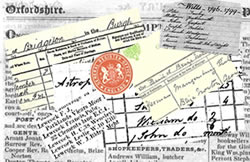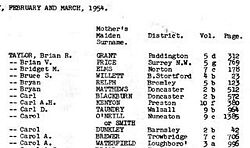Difference between revisions of "Records Office Guide"
| Line 147: | Line 147: | ||
*[[School Records]] | *[[School Records]] | ||
*[[Taxation Records]] | *[[Taxation Records]] | ||
| − | *[[Wills and Probate ]]Work in progress | + | *[[Wills and Probate ]]''Work in progress'' |
Revision as of 22:07, 20 March 2007
Contents
A Guide To Information Available In Your Local Records Office
Index to Counties
The biggest headache in locating record offices is boundary changes. Records that relate to your area often end up archived in their original shire county despite the introduction of unitary authorities and metropolitan boroughs and counties.
To view the set up of Counties Prior to the changes implemented in 1974, click here
| Channel Islands and Crown Dependencies including the Isle of Man |
Births Marriages and Deaths
The system of civil registration of births, marriages and deaths in England and Wales was established on July 1st 1837. The country was divided into registration districts based on poor law unions. Today the system is based on the areas of local authorities. Each registration district is under the control of Superintendent Registrars and divided into sub-districts. Copies of registers are sent to the Registrar General and the indexes are compiled.
The indexes are divided into quarters for each year up to 1983. Remember that the index relates to the time of registration NOT the time of the event. Since 1984 events have been arranged in alphabetical indexes covering a full year. Exact place of birth is not given, just the name of the Registration District with a different reference numbering system.
The Office for National Statistics (ONS) Indexes and copies have been distributed nationwide. Some can be viewed in local libraries, County Records Offices or even Local Archive and History Study Centres. You will not be charged for viewing these images. These images are available online but the odd sheet is missing.
Burial Records
- Text from the record-office-guide-revamp which has been tidied up/edited.
Parish Records
- Text from the record-office-guide-revamp which has been tidied up/edited.
Census Returns
What will I find?
On each census you should find recorded: Address, name, relationship to the head of the family, marital status, age at last birthday, gender, occupation, birthplace, disability.
Some censi only make reference to a household number rather than a formal numbered address.
The 1841 Census did not declare relationship to head of household and was lacking in the detail of later censi.
Ages of adults over the age of 15 were rounded up or down to the nearest 5 years.
For example, a man and wife aged 52 and 48 would both be recorded as aged 50.
Ages of children below 15 were far more accurate.
You may find that with institutions, small villages and hamlets, residents or inmates are recorded using just intials, age and/or a birthplace (if known) or otherwise just initials.
Each entry on a census is given a four part reference: class (RG or HO) + piece + folio + page number, which is a unique reference given to a particular page. Everyone recorded on one particular sheet will have this same code. The lower example to the right is recorded as RG13/3194/50/2. The image shows the class and piece reference found at the foot of the sheet.
Census dates in the Victorian Era
- 1901 ref always start RG13 - census date 31st March
- 1891 ref always start RG12 - census date 5th April
- 1881 ref always start RG11 - census date 3rd April
- 1871 ref always start RG10 - census date 2nd april
- 1861 ref always start RG9 - census date 7th April
- 1851 ref always start HO - census date 30th March
- 1841 ref always start HO - census date 7th June
Census records are usually transcribed for online viewing in this format:
Name
Parent or spouse names
Birth Year
Birthplace
Relation (not 1841),
Civil parish,
County or Island (1841 census terms as born in county or out of county- OOC)
For common terms, names and abbreviations found on a census, click here !
How are they useful ?
When evaluating census information it is worth remembering that they are merely a snapshot record made every ten years. Ancestors may be missing due to war or may simply have been in transit on census night and lodged somewhere. There is an element of innacuracy that researchers need to factor in to their findings and they should be used with other sources of evidence to gain a fuller picture. Particular details on these records may give clues as to personal wealth and social standing e.g. when an entry declares living by own means. If you can follow the record of one person alone through the decades you can sometimes see how a person's life or career has developed e.g. at 16 a person is a groom, at 26 is a clerk, at 36 has a family, at 46 has a factory, at 56 has servants and so on.
Census records provide a useful framework in that they allow us to track the progress of a family over a long period of time. Sudden ommissions may point towards other searches such as death records, census entries in army barracks or institutions and maritime records. Conversely, a known death or marriage between census years enables us to switch our attention to other family names. Modern websites such as Ancestry have made census access more convenient but there are mistranscriptions aplenty which should also be borne in mind. See Census Search for alternative tips on how to use the search facilities on that site.
Other Types of Records
- Archive Collections Needs text
- Architectural drawings and building plans Needs text
- Coroner’s Records
- Court Sessions and Victualler's Licences Needs text
- Directories: Trade, Street and City Needs proof reading
- Electoral Registers and Poll Books
- Emigration and Immigration Needs text
- Hospital Records Needs proof reading
- Manorial, Land and Estate Deeds Needs text
- Maps: Tithe and Ordnance Survey Needs proof reading
- Military Records
- Newspapers and Journals Needs proof reading
- Photographs Needs text
- Poor Law and Workhouse Records OC working on this one
- Records of Merchant Seamen
- School Records
- Taxation Records
- Wills and Probate Work in progress



